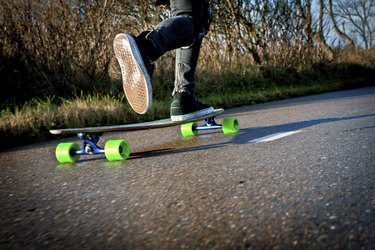
The physical activity skateboarding entails makes it a moderately intense aerobic activity, according to the Centers for Disease Control and Prevention. Whether you're performing daring tricks or cruising down the sidewalk, skateboarding burns calories and improves your health. If you're interested in incorporating skateboarding into your exercise regimen, choose the type of board that works best for your fitness goals. For example, some people might require a trick skateboard so they can perform freestyle moves, while others might prefer a skateboard designed for coasting.
Step 1
Use your lower body power to propel yourself. To steer, tilt to one side or the other. Both activities require muscle endurance and control.
Video of the Day
Step 2
Skateboard 150 minutes a week for a healthy amount of exercise. The longer you skateboard, the more health benefits you experience, such as improved fitness and increased energy levels.
Step 3
Skate faster to increase the amount of energy your body consumes and to push your muscles harder. For those who want to lose or maintain weight, vigorous skateboarding can assist in your fitness efforts. Eating a proper diet and engaging in separate strength-training exercises rounds out a healthy lifestyle.
Step 4
Perform intense tricks that require advanced physical fitness, such as complicated midair maneuvers and high jumps, if you are an accomplished skateboarder. Though beginners should not attempt difficult maneuvers, experienced skateboarders can burn a significant number of calories reaching high speeds.
Step 5
Exercise in a hilly area to make the workout more vigorous if you are an experienced skater. Pushing the skateboard up an incline is more difficult than coasting, so it will increase the number of calories you burn and the effectiveness of the aerobic exercise.
Warning
Although skateboarding is an effective exercise, there is always a risk of injury, especially if you are new to the sport. Typical skateboarding accidents include sprains, lacerations and bone injuries due to falls. If you fail to wear a helmet, you risk hitting your head on a hard surface, which could lead to a concussion or other serious injuries. If you’re new to skateboarding, find a paved, flat area free of debris to practice your skills. Wear appropriate safety gear. Helmets, wrist guards, knee pads and elbow pads will protect you against most potential injuries. Start off slow and focus on maintaining your balance. As your skills improve, increase your speed.
Video of the Day